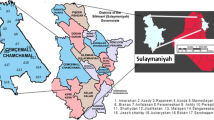Abstract
The presence of alpha emitting radionuclides in the environment assumes importance since they are found to be carcinogenic. This paper reports the results of an exhaustive and systematic measurement of alpha radioactivity using solid state nuclear track detector (SSNTD) in drinking water in different parts of India covering the entire Ganges Basin – West Bengal, Bihar and Uttar Pradesh where arsenic contamination is severe. The alpha activity in the samples was found in the range of 8 to 800 Bq/l in West Bengal, 90 to 1,000 Bq/l in Uttar Pradesh and 60 to 1,000 Bq/l in Bihar – much higher alpha activity value than MCL value given by US EPA. The concentration of alpha activity has a positive correlation with that of arsenic.


Similar content being viewed by others
References
Das, D. et al. (1996). Arsenic in ground water in six districts of West Bengal, India. Environmental Geochemistry and Health, 18, 5–15.
Ghosh, D. et al. (2004). Measurement of alpha radioactivity in arsenic contaminated tubewell drinking water using CR-39 detectors. Radiation Measurement, 38, 19–22.
Henahaw, D. L. (1989). Proceedings of the international workshop on radon monitoring in radioprotection, environmental radioactivity and earth sciences. ICTP, Trieste, Italy April 3–14, p. 70.
US EPA (1996a). Radon and drinking water.
US EPA (1996b). Radon in water.
United Nations Scientific Committee on the Effects of Atomic Radiation (UNSCEAR) (1993). Sources and effects of ionizing radiation. 1993 Report to the General Assembly, United Nations, New York.
Winters, T. H. et al. (1982). Radioactivity in cigarette smoke. New England Journal of Medicine, 306(6), 364–365.
World Health Organization (WHO) (1996). Indoor quality: A risk-based approach to health criteria for radon indoors: Report on a WHO Working Group, Eilat, Iseael, 28 March–4 April 1993. EUR/ICP/CEH 108(A). Denmark: WHO Regional Office for Europe.
Acknowledgement
The authors would like to acknowledge Prof. Asok Nath Basu, Vice chancellor, Jadavpur University, for his extraordinary enthusiasm, inspiration and active guidance. They are also grateful to Dr. Debasis Ghose, VECC, Kolkata, for his valuable suggestions at any stage of the work. They are also thankful to Prof. Dipankar Chakraborty, Director, School of Environmental Studies, Jadavpur University, for measurement of arsenic concentration in water samples and providing samples also and Prof. S. K. Acharyya, Department of Geology, Jadavpur University, Dr. Abdul Kayum Jafry for providing them the arsenic contaminated drinking water samples.
Author information
Authors and Affiliations
Corresponding author
Rights and permissions
About this article
Cite this article
Ghosh, D., Deb, A., Patra, K.K. et al. Double Health Risk in Arsenic Contaminated Drinking Water – Evidence of Enhanced Alpha Radioactivity. Water Air Soil Pollut 187, 81–87 (2008). https://doi.org/10.1007/s11270-007-9499-5
Received:
Accepted:
Published:
Issue Date:
DOI: https://doi.org/10.1007/s11270-007-9499-5




